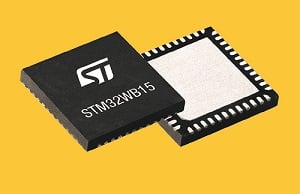The new devices are power-conscious to embedded applications including wearables, IoT endpoints and industrial automation equipment
 Combining entry-level features with extra power savings for longer-lasting performance are the new dual-core STM32WB15 and STM32WB10 Value Line by STMicroelectronics.
Combining entry-level features with extra power savings for longer-lasting performance are the new dual-core STM32WB15 and STM32WB10 Value Line by STMicroelectronics.
They include an Arm Cortex-M4 processor to run the main application and a Cortex-M0+ to handle Bluetooth 5.2 connectivity, ensuring real-time performance from each. The radio stage has a 102dBm link budget to ensure reliable connections over long distances and balun circuitry integration that saves board space and reduces the bill of materials.
With a new ultra-power-saving mode that allows the radio to remain operational, and carefully tailored peripherals and memory, the new devices are cost-sensitive, power-conscious to embedded applications including wearables, beacons, smart circuit breakers, trackers, IoT endpoints and industrial automation equipment.
The Software Development Kit (SDK) for each MCU includes standardised radio protocol stacks and openness to proprietary protocols with a set of security mechanisms that ensure safe software updates for brand protection and device integrity, with Proprietary Code Read-Out Protection (PCROP) to guard intellectual property.
With these new devices, the STM32WB series scales across package variants, offering options including extended GPIOs and pin-to-pin compatibility between similar packages of the portfolio. Customers can easily migrate designs between devices to take advantage of different features and memory densities, leveraging pin-compatibility across packages.
The development ecosystem includes:
- STM32Cube certified radio stacks that support various profiles, software expansion packs and sample code
- STM32CubeMX configurator and initialisation code generator
- STM32CubeIDE development environment
- STM32CubeMonitor-RF evaluation tool
- Nucleo hardware tools.
The STM32WB15 and STM32WB10 Value Line MCUs are in production now, offering various pin-compatible configurations in the QFN48 package.






